Software Development Life Cycles PDF
76 Pages23990 Words252 Views
Added on 2022-01-23
Software Development Life Cycles PDF
Added on 2022-01-23
ShareRelated Documents
Report on Software Development Life Cycles
Submitted by: Jharana
Adhikari Submitted
to:
Mr. Odilia Gosselin
(Manager of Techno Dynamic Company Ltd.)
Submitted by: Jharana
Adhikari Submitted
to:
Mr. Odilia Gosselin
(Manager of Techno Dynamic Company Ltd.)

Executive Summary
To the Manager (Mr. Odilia Gosselin),
Techno Dynamics Company Ltd.
Enfield, London, UK
Respected madam,
In this report, I have included the description of predictive and adaptive software development
models considering at least two iterative and two sequential models and also the risks involved in
each of the models and how the risk can be mitigated /managed in each model by taking a
reference of the spiral model.
Part: 1
Introduction:
The large insurance company predominantly operating in United Kingdom is now offering its
products and services to many of the countries in its drive to grow and become a large
international company. The system that this company is using to keep track of its customer
enquiries about information and purchase of its products and services needs to be updated to
reflect the changes in the way it operates. So, to go towards the international market this
company needs to update its old system and replace it with new system, which provides other
various services. As the customers in other countries will be using wide range of currencies to
purchase the products and the insurance company need to allow for the fluctuating currency
exchange rates in its new system. For this software development task our business consultancy
To the Manager (Mr. Odilia Gosselin),
Techno Dynamics Company Ltd.
Enfield, London, UK
Respected madam,
In this report, I have included the description of predictive and adaptive software development
models considering at least two iterative and two sequential models and also the risks involved in
each of the models and how the risk can be mitigated /managed in each model by taking a
reference of the spiral model.
Part: 1
Introduction:
The large insurance company predominantly operating in United Kingdom is now offering its
products and services to many of the countries in its drive to grow and become a large
international company. The system that this company is using to keep track of its customer
enquiries about information and purchase of its products and services needs to be updated to
reflect the changes in the way it operates. So, to go towards the international market this
company needs to update its old system and replace it with new system, which provides other
various services. As the customers in other countries will be using wide range of currencies to
purchase the products and the insurance company need to allow for the fluctuating currency
exchange rates in its new system. For this software development task our business consultancy
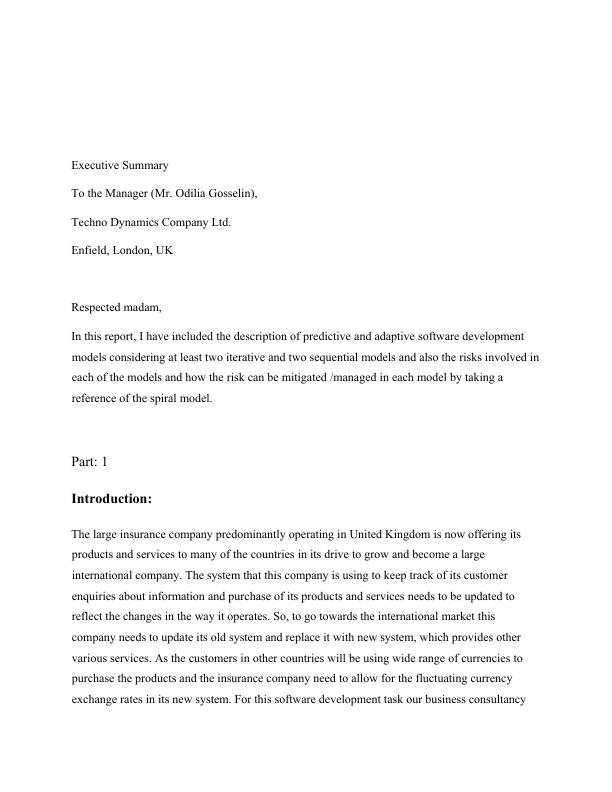
company has won contract and I was hired as systems analyst to develop new system of
insurance company.
My Role as System Analyst
For the development of this project, I have to work with my colleagues as part of a development
team. In past the insurance company has small development team, which solely developed the
old system so while developing this new system in-house team will also work alongside us for
better understanding of their requirements. I am going to manage the project analysis and design
stage of new system. Firstly, I am going to update the in-house team on new methodologies of
system development used to analyze systems.
1. Description of predictive and adaptive software development models considering at least
two iterative and two sequential models.
Software Development Life Cycle:
The software development life cycle (SDLC) is an outline identifying tasks executed at each
stage in the software development procedure. SDLC is a design tracked by a development team
within the software organization.
It consists of a comprehensive plan describing how to develop, maintain and replace specific
software. The life cycle defines a methodology for improving the quality of software and the
overall development process.
The software development life cycle is also known as the software development process.
(Techopedia, 2019)
Stages of Software Development Life Cycle (SDLC):
insurance company.
My Role as System Analyst
For the development of this project, I have to work with my colleagues as part of a development
team. In past the insurance company has small development team, which solely developed the
old system so while developing this new system in-house team will also work alongside us for
better understanding of their requirements. I am going to manage the project analysis and design
stage of new system. Firstly, I am going to update the in-house team on new methodologies of
system development used to analyze systems.
1. Description of predictive and adaptive software development models considering at least
two iterative and two sequential models.
Software Development Life Cycle:
The software development life cycle (SDLC) is an outline identifying tasks executed at each
stage in the software development procedure. SDLC is a design tracked by a development team
within the software organization.
It consists of a comprehensive plan describing how to develop, maintain and replace specific
software. The life cycle defines a methodology for improving the quality of software and the
overall development process.
The software development life cycle is also known as the software development process.
(Techopedia, 2019)
Stages of Software Development Life Cycle (SDLC):

Figure 1: SDLC Phase
1. Requirement Phase:
Requirement gathering and analysis is the most important phase in the software
development lifecycle. Business Analyst collects the requirement from the
Customer/Client as per the client’s business needs and documents the requirements in the
Business Requirement Specification (document name varies depends upon the Organization.
1. Requirement Phase:
Requirement gathering and analysis is the most important phase in the software
development lifecycle. Business Analyst collects the requirement from the
Customer/Client as per the client’s business needs and documents the requirements in the
Business Requirement Specification (document name varies depends upon the Organization.
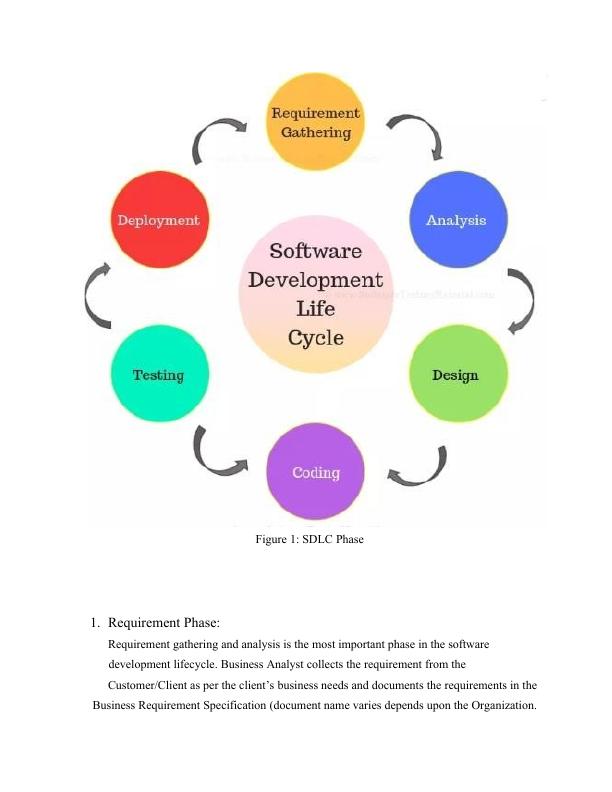
Some examples are Customer Requirement Specification (CRS), Business Specification (BS),
etc., and provides the same to Development Team.
2. Analysis Phase:
Once the requirement gathering and analysis is done the next step is to define and
document the product requirements and get them approved by the customer. This is
done through the SRS (Software Requirement Specification) document. SRS consists
of all the product requirements to be designed and developed during the project life
cycle. Key people involved in this phase are Project Manager, Business Analyst and
Senior members of the Team. The outcome of this phase is the Software Requirement
Specification.
3. Design Phase:
It has two steps:
HLD – High-Level Design – It gives the architecture of the software product to be
developed and is done by architects and senior developers
LLD – Low-Level Design – It is done by senior developers. It describes how each and
every feature in the product should work and how every component should work. Here,
only the design will be there and not the code
The outcome from this phase is High-Level Document and Low-Level Document which
works as an input to the next phase
4. Development Phase:
Developers of all levels (seniors, juniors, freshers) involved in this phase. This is the
phase where we start building the software and start writing the code for the product. The
outcome from this phase is Source Code Document (SCD) and the developed product.
5. Testing and Integration.
When the software is ready, it is sent to the testing department where Test team tests it
thoroughly for different defects. They either test the software manually or using
automated testing tools depends on the process defined in STLC (Software Testing Life
Cycle) and ensure that each and every component of the software works fine. Once the
QA makes sure that the software is error-free, it goes to the next stage, which is
etc., and provides the same to Development Team.
2. Analysis Phase:
Once the requirement gathering and analysis is done the next step is to define and
document the product requirements and get them approved by the customer. This is
done through the SRS (Software Requirement Specification) document. SRS consists
of all the product requirements to be designed and developed during the project life
cycle. Key people involved in this phase are Project Manager, Business Analyst and
Senior members of the Team. The outcome of this phase is the Software Requirement
Specification.
3. Design Phase:
It has two steps:
HLD – High-Level Design – It gives the architecture of the software product to be
developed and is done by architects and senior developers
LLD – Low-Level Design – It is done by senior developers. It describes how each and
every feature in the product should work and how every component should work. Here,
only the design will be there and not the code
The outcome from this phase is High-Level Document and Low-Level Document which
works as an input to the next phase
4. Development Phase:
Developers of all levels (seniors, juniors, freshers) involved in this phase. This is the
phase where we start building the software and start writing the code for the product. The
outcome from this phase is Source Code Document (SCD) and the developed product.
5. Testing and Integration.
When the software is ready, it is sent to the testing department where Test team tests it
thoroughly for different defects. They either test the software manually or using
automated testing tools depends on the process defined in STLC (Software Testing Life
Cycle) and ensure that each and every component of the software works fine. Once the
QA makes sure that the software is error-free, it goes to the next stage, which is
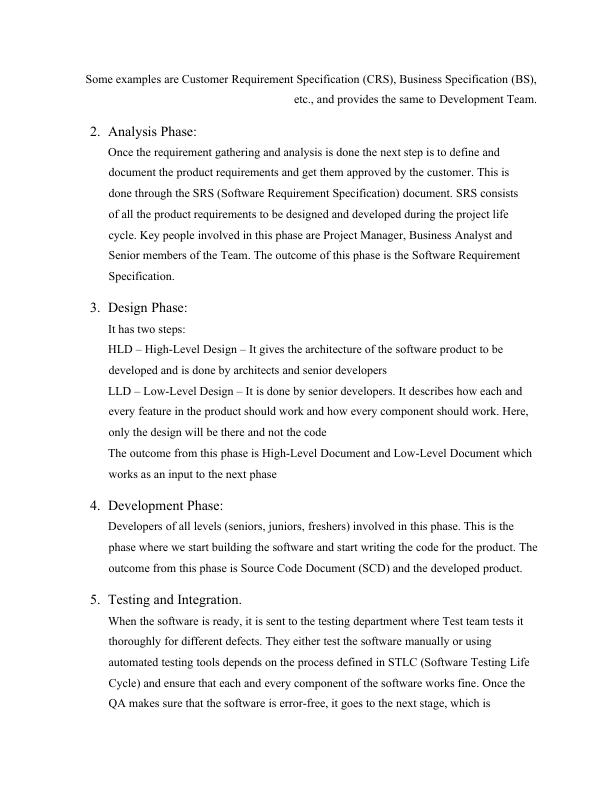
Implementation. The outcome of this phase is the Quality Product and the Testing
Artifacts. After the successful test of the application we need to integrate the various
modules like login, signup, upload, claim, services.
6. Deployment & Maintenance Phase:
After successful testing, the product is delivered/deployed to the customer for their use.
Deployment is done by the Deployment/Implementation engineers. Once when the
customers start using the developed system then the actual problems will come up and
needs to be solved from time to time. Fixing the issues found by the customer comes in
the maintenance phase. 100% testing is not possible – because, the way testers test the
product is different from the way customers use the product. Maintenance should be done
as per SLA (Service Level Agreement)
(Rajkumar, August 10, 2019)
P1 Describe two iterative and two sequential software lifecycle models.
Iterative Models:
The iterative models are particular implementation of a software development lifecycle that
focuses on an initial, simplified implementation, which then progressively gains more
complexity and a broader feature set until the final system is complete. In this type of model’s
enhancements can be recognized quickly with implementation throughout each iteration. The
two iterative models which I am going to describe are prototype and agile models.
Agile model Please add sprint, scum. Standup meeting, client’s feedback, backlog,
sprint backlog. Please include the manifesto of agile.
“Agile SDLC model is a combination of iterative and incremental process models with focus on
process adaptability and customer satisfaction by rapid delivery of working software product.
Agile Methods break the product into small incremental builds. These builds are provided in
iterations.” (n.d, 2018) In this model every project is handled differently and existing methods
Artifacts. After the successful test of the application we need to integrate the various
modules like login, signup, upload, claim, services.
6. Deployment & Maintenance Phase:
After successful testing, the product is delivered/deployed to the customer for their use.
Deployment is done by the Deployment/Implementation engineers. Once when the
customers start using the developed system then the actual problems will come up and
needs to be solved from time to time. Fixing the issues found by the customer comes in
the maintenance phase. 100% testing is not possible – because, the way testers test the
product is different from the way customers use the product. Maintenance should be done
as per SLA (Service Level Agreement)
(Rajkumar, August 10, 2019)
P1 Describe two iterative and two sequential software lifecycle models.
Iterative Models:
The iterative models are particular implementation of a software development lifecycle that
focuses on an initial, simplified implementation, which then progressively gains more
complexity and a broader feature set until the final system is complete. In this type of model’s
enhancements can be recognized quickly with implementation throughout each iteration. The
two iterative models which I am going to describe are prototype and agile models.
Agile model Please add sprint, scum. Standup meeting, client’s feedback, backlog,
sprint backlog. Please include the manifesto of agile.
“Agile SDLC model is a combination of iterative and incremental process models with focus on
process adaptability and customer satisfaction by rapid delivery of working software product.
Agile Methods break the product into small incremental builds. These builds are provided in
iterations.” (n.d, 2018) In this model every project is handled differently and existing methods

are tailored to best suit requirements of project. All tasks are divided in small time frames for
delivering specific features in release. It gives priorities to working software and customer
collaboration over comprehensive documentation and contract negotiation. This model also
allows proper response to change than following the project plan and every iteration includes
cross functional team working simultaneously.
Agile model is iterative and team-based way to development. This model gives importance in
rapid delivery of system in complete functional components. All time is time boxed in phases
known as sprints rather than creating tasks and schedules for system development. While starting
each sprint has defined duration although time may vary according to project and also the
running list of deliveries. Sometime if planned work for sprint cannot be completed then work is
reprioritized again and information is used for further sprint planning. When the work is
completed then it is reviewed and evaluated by team and customers. This model relies in high
level of customer involvement throughout development process and it is more especially during
reviewing the system.
There are various phases in agile
model which are illustrated below:
-
• Requirements: The initial
step in this model is to
gather the system
requirements. As this
model doesn’t need the full
documentation to rather
software requirements
meeting is held and all
decision are implemented.
• Design: In this stage with the help of various software designing tools the design of
software is prepared. It can be prepared as the demo version and other important features
can be added further while continuing project. Here also the clients provide their
feedback to system and system is altered according to their need.
delivering specific features in release. It gives priorities to working software and customer
collaboration over comprehensive documentation and contract negotiation. This model also
allows proper response to change than following the project plan and every iteration includes
cross functional team working simultaneously.
Agile model is iterative and team-based way to development. This model gives importance in
rapid delivery of system in complete functional components. All time is time boxed in phases
known as sprints rather than creating tasks and schedules for system development. While starting
each sprint has defined duration although time may vary according to project and also the
running list of deliveries. Sometime if planned work for sprint cannot be completed then work is
reprioritized again and information is used for further sprint planning. When the work is
completed then it is reviewed and evaluated by team and customers. This model relies in high
level of customer involvement throughout development process and it is more especially during
reviewing the system.
There are various phases in agile
model which are illustrated below:
-
• Requirements: The initial
step in this model is to
gather the system
requirements. As this
model doesn’t need the full
documentation to rather
software requirements
meeting is held and all
decision are implemented.
• Design: In this stage with the help of various software designing tools the design of
software is prepared. It can be prepared as the demo version and other important features
can be added further while continuing project. Here also the clients provide their
feedback to system and system is altered according to their need.
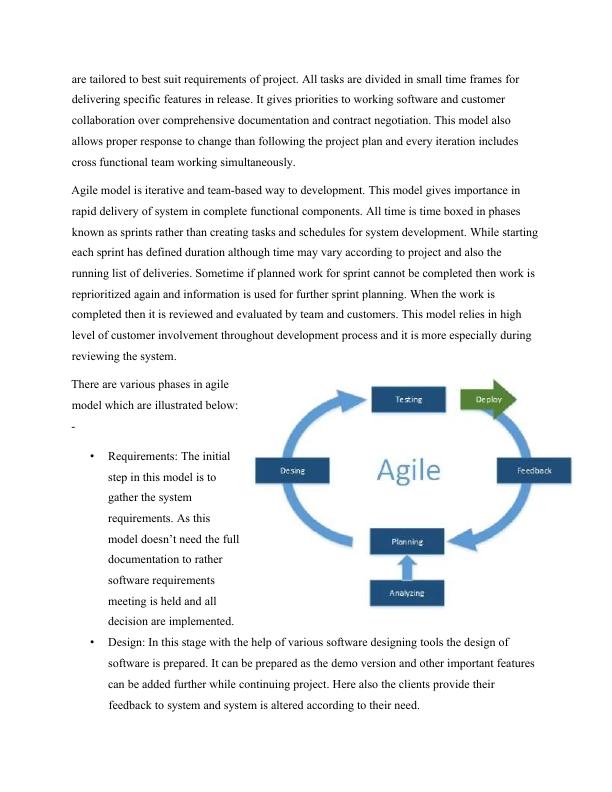
• Development: Here the designed demo version is brought into implementation for the
user feedback and in end of this phase system will almost be ready. Customer
collaboration and feedback plays important role in this stage.
• Testing and feedback: In this ending phase the overall system wrapping is done with all
the testing required. After the customer is satisfied with the developed system it is handed
to client.
Advantages Disadvantages
It is very easy, realistic approach that
provides flexibility to developers. And
promotes teamwork and cross training.
There will be high individual dependency as
minimum documentation is generated.
It provides continuous attention to technical
excellence and good design.
As there are strict delivery management
adjustments can be dictated to meet deadlines.
Minimum rules and documentation can be
easily employed.
It is very difficult to implement this model
without overall plan, an agile leader and agile
project manager.
It is best suitable for environment where
requirements may change during development
process.
If customer representative is not clear about
the outcome of project then team can easily
get off the track.
Resource requirements are minimum and only
little planning is required.
During the development transfer or recruiting
of new member in project will be quite
challenging due to lack of documentation.
Sequential models:
In this type of model developer have to follow some rules, regulations and defined orders for
completing the project. Here I am going to describe two sequential model of software
development which are waterfall model and V model.
Waterfall:
user feedback and in end of this phase system will almost be ready. Customer
collaboration and feedback plays important role in this stage.
• Testing and feedback: In this ending phase the overall system wrapping is done with all
the testing required. After the customer is satisfied with the developed system it is handed
to client.
Advantages Disadvantages
It is very easy, realistic approach that
provides flexibility to developers. And
promotes teamwork and cross training.
There will be high individual dependency as
minimum documentation is generated.
It provides continuous attention to technical
excellence and good design.
As there are strict delivery management
adjustments can be dictated to meet deadlines.
Minimum rules and documentation can be
easily employed.
It is very difficult to implement this model
without overall plan, an agile leader and agile
project manager.
It is best suitable for environment where
requirements may change during development
process.
If customer representative is not clear about
the outcome of project then team can easily
get off the track.
Resource requirements are minimum and only
little planning is required.
During the development transfer or recruiting
of new member in project will be quite
challenging due to lack of documentation.
Sequential models:
In this type of model developer have to follow some rules, regulations and defined orders for
completing the project. Here I am going to describe two sequential model of software
development which are waterfall model and V model.
Waterfall:
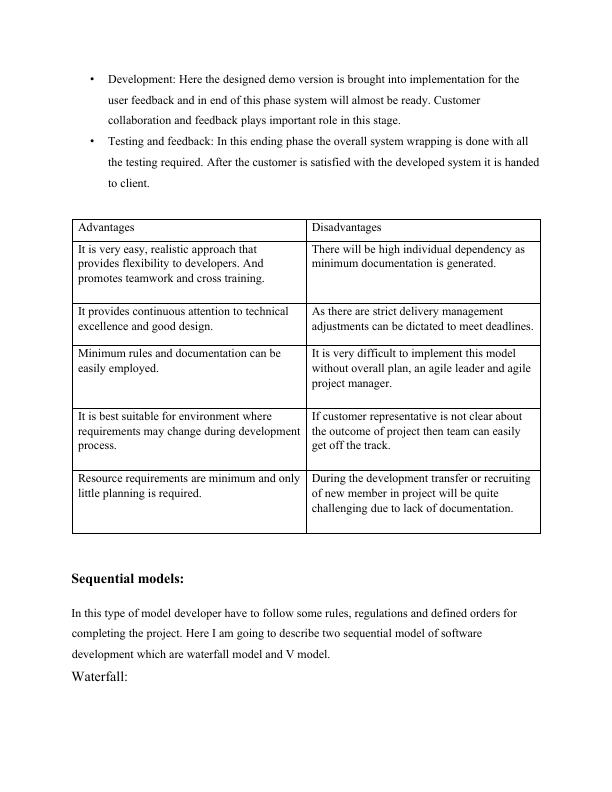
End of preview
Want to access all the pages? Upload your documents or become a member.
Related Documents
ASSIGNMENT NAME: ASSIGNMENT 1 ASSIGNMENT NAME: ASSIGNMENT 1 ASSIGNMENT NAME: ASSIGNMENT 1 ASSIGNMENT NAME: ASSIGNMENT 1 ASSIGNMENT NAME: ASSIGNMENT 1 ASSIGNMENT NAME: ASSIGNMENT 1 ASSIGNMENT NAME: ASSlg...
|18
|4969
|84
Himilayan Hotel System Analysis and Designlg...
|30
|6842
|133
Characteristics or Phases in Project Life Cyclelg...
|9
|1232
|16
Software Development Life Cycle Assignmentlg...
|27
|9120
|232
ICT Project Management: Methodologies, SDLC, Waterfall, PLClg...
|6
|1018
|140
System Analysis and Designlg...
|13
|1658
|447
